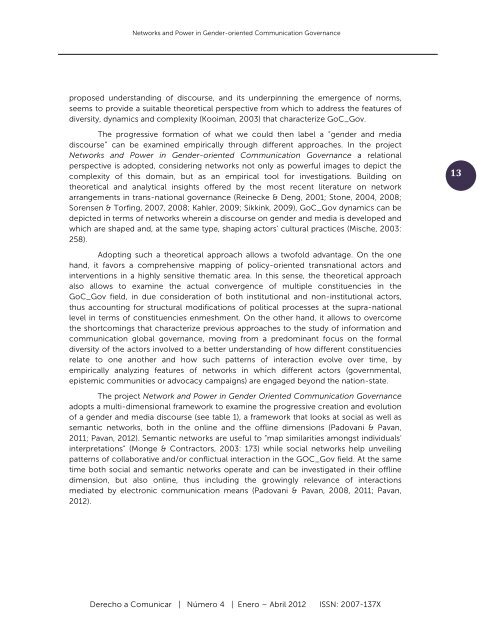21aiiMmFK
21aiiMmFK
21aiiMmFK
You also want an ePaper? Increase the reach of your titles
YUMPU automatically turns print PDFs into web optimized ePapers that Google loves.
Networks and Power in Gender-oriented Communication Governance<br />
proposed understanding of discourse, and its underpinning the emergence of norms,<br />
seems to provide a suitable theoretical perspective from which to address the features of<br />
diversity, dynamics and complexity (Kooiman, 2003) that characterize GoC_Gov.<br />
The progressive formation of what we could then label a “gender and media<br />
discourse” can be examined empirically through different approaches. In the project<br />
Networks and Power in Gender-oriented Communication Governance a relational<br />
perspective is adopted, considering networks not only as powerful images to depict the<br />
complexity of this domain, but as an empirical tool for investigations. Building on<br />
theoretical and analytical insights offered by the most recent literature on network<br />
arrangements in trans-national governance (Reinecke & Deng, 2001; Stone, 2004, 2008;<br />
Sorensen & Torfing, 2007, 2008; Kahler, 2009; Sikkink, 2009), GoC_Gov dynamics can be<br />
depicted in terms of networks wherein a discourse on gender and media is developed and<br />
which are shaped and, at the same type, shaping actors’ cultural practices (Mische, 2003:<br />
258).<br />
13 <br />
Adopting such a theoretical approach allows a twofold advantage. On the one<br />
hand, it favors a comprehensive mapping of policy-oriented transnational actors and<br />
interventions in a highly sensitive thematic area. In this sense, the theoretical approach<br />
also allows to examine the actual convergence of multiple constituencies in the<br />
GoC_Gov field, in due consideration of both institutional and non-institutional actors,<br />
thus accounting for structural modifications of political processes at the supra-national<br />
level in terms of constituencies enmeshment. On the other hand, it allows to overcome<br />
the shortcomings that characterize previous approaches to the study of information and<br />
communication global governance, moving from a predominant focus on the formal<br />
diversity of the actors involved to a better understanding of how different constituencies<br />
relate to one another and how such patterns of interaction evolve over time, by<br />
empirically analyzing features of networks in which different actors (governmental,<br />
epistemic communities or advocacy campaigns) are engaged beyond the nation-state.<br />
The project Network and Power in Gender Oriented Communication Governance<br />
adopts a multi-dimensional framework to examine the progressive creation and evolution<br />
of a gender and media discourse (see table 1), a framework that looks at social as well as<br />
semantic networks, both in the online and the offline dimensions (Padovani & Pavan,<br />
2011; Pavan, 2012). Semantic networks are useful to “map similarities amongst individuals’<br />
interpretations” (Monge & Contractors, 2003: 173) while social networks help unveiling<br />
patterns of collaborative and/or conflictual interaction in the GOC_Gov field. At the same<br />
time both social and semantic networks operate and can be investigated in their offline<br />
dimension, but also online, thus including the growingly relevance of interactions<br />
mediated by electronic communication means (Padovani & Pavan, 2008, 2011; Pavan,<br />
2012).<br />
Derecho a Comunicar | Número 4 | Enero – Abril 2012 ISSN: 2007-137X



